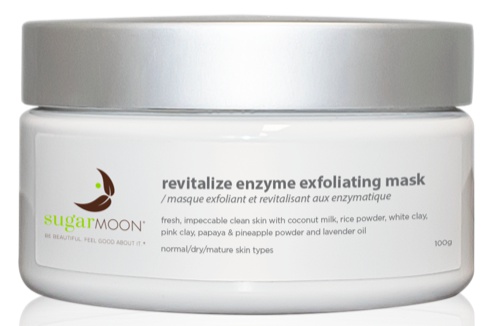
Revitalize Enzymes Exfoliating Mask
Highlights
Key Ingredients
Skim through
| Ingredient name | what-it-does | irr., com. | ID-Rating |
|---|---|---|---|
| Kaolin (White Clay) | colorant, abrasive/scrub | 0, 0 | goodie |
| Quartz (Pink Clay) | abrasive/scrub | ||
| Cocos Nucifera (Coconut) Shell Powder | abrasive/scrub, emollient | ||
| Oryza Sativa (Rice) Powder* | |||
| Avena Sativa (Oat) Kernel Flour | soothing, antioxidant, emollient | goodie | |
| Ananas Comosus (Pineapple Powder) | |||
| Carica Papaya (Papaya Powder) | |||
| Lavandula Angustifolia Oil (Lavender) Essential Oil* | antimicrobial/antibacterial, perfuming | icky |
Sugarmoon Revitalize Enzymes Exfoliating MaskIngredients explained
Kaolin is a type of clay or to be precise, a naturally occurring hydrous aluminum silicate. When you hear clay, you probably think of a muddy greenish-black mess, but that one is bentonite, and this one is a fine, white powder. It is so white that it's also often used, in small amounts, as a helper ingredient to give opacity and whiteness to the cosmetic formulas.
As a clay, it's absorbent and can suck up excess sebum and gunk from your skin, but less so than the more aggressive bentonite. As it's less absorbent, it's also less drying and gentler on the skin, so it's ideal for dry and sensitive skin types.
The powder of the finely ground shells of the Coconut. It comes in different sizes and is used as a scrub.

A finely powdered form of Oat Extract that has the same skin soothing, skin protecting and antioxidant benefits we have written about at Avena Sativa Kernel Extract. It is loaded with skin-goodies such as anti-inflammatory agent beta-glucan, skin nourishing lipids, and moisturizing carbohydrates. A real goodie for dry, irritated, inflamed or eczema-prone skin.
This ingredient name is not according to the INCI-standard. :( What, why?!

We have to start by writing how fascinated we are by the amazing lavender fields of Provance and we do love pretty much everything about lavender: its look, its color, its scent.... but, when it comes to skincare, lavender is a questionable ingredient that you probably do not want in your skincare products.
First, let us start with the pros: it has a lovely scent, so no wonder that it is popular as a fragrance ingredient in natural products wanting to be free from synthetic fragrances but still wanting to smell nice. The scent of lavender is famous for having calming and relaxing properties and some smallish scientific studies do support that. Inhaled volatile compounds seem to have a soothing effect on the central nervous system and studies have shown that lavender aromatherapy can improve patient's anxiety and experience in hospitals.
You may also want to take a look at...
| what‑it‑does | colorant | abrasive/scrub |
| irritancy, com. | 0, 0 |
| what‑it‑does | abrasive/scrub |
| what‑it‑does | abrasive/scrub | emollient |
| what‑it‑does | soothing | antioxidant | emollient |
| what‑it‑does | antimicrobial/antibacterial | perfuming |





